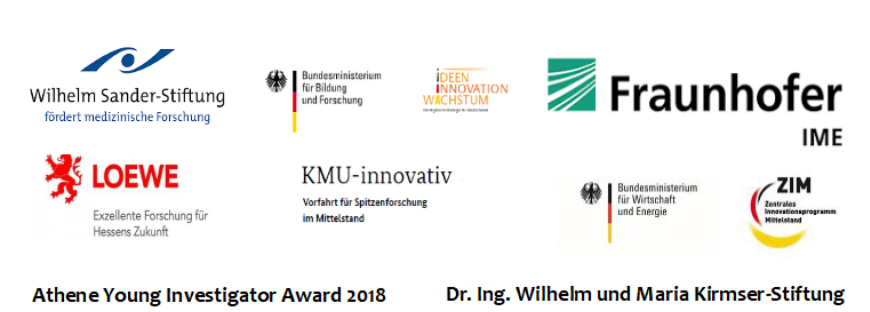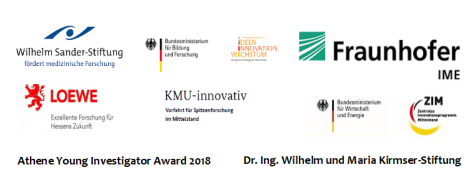

Small extracellular vesicles (exosomes) are key players in intercellular communication. They trigger various biological processes by the transfer of cellular components such as microRNAs (miRs). Our research aims to identify novel miR functionalities in various diseases and to investigate their role in intercellular communication. We transfer our findings into new treatment strategies.
MiR-574-5p as a biomarker for stratification of PGE2-dependent tumors
MiRs are a class of small non-coding RNAs which contribute to the post-transcriptional regulation of gene expression. We identified a novel function of miR-574-5p. It acts as an RNA decoy to CUG-RNA binding protein 1 (CUGBP1) and antagonizes its functions as a repressor of microsomal prostaglandin E synthase 1 (mPGES-1), a key enzyme in the prostaglandin biosynthesis. An elevated intracellular miR-574-5p expression is directly associated with enhanced synthesis of prostaglandin E2 (PGE2) (Saul et al, FASEB J 2019), an important pro-inflammatory lipid mediator. The newly discovered association between miR-574-5p and PGE2 qualifies miR-574-5p as a minimally invasive biomarker to select cancer patients who are likely to respond to the pharmacological inhibition of PGE2.
In collaboration with the University of Giessen Marburg Lung Center, an exploratory biomarker study started in February 2019 with ~150 lung cancer patients to validate miR-574-5p as a tumor and stratification marker. On this basis, we develop a diagnostic kit in collaboration with the Prolytic GmbH (Frankfurt/Main), which will provide a great opportunity to improve anticancer treatment.
Extracellular miRs are promising minimal invasive diagnostic biomarkers. However, up to date a robust and valid diagnostic analytic is still lacking. In collaboration with Prolytic GmbH, we developed a miR analytic method using a quantitative polymerase chain reaction (qPCR), which is validated under Good Laboratory Practice (GLP) to ensure the reproducibility of the obtained results (Fauth et al. FASEB BioAdvance 2019).
The role of extracellular miR-574-5p in the microenvironment of different PGE2 dependent tumors
We investigate whether paracrine mechanisms of miR-574-5p play a crucial role in tumor development. Therefore, we analyze whether miR-574-5p is transferred within exosomes between cancer cells and cells of the tumor microenvironment to influence tumor progression. We have chosen lung cancer and neuroblastoma as contrary tumor model systems. Both tumor types are PGE2 dependent but differ in the cellular location of PGE2 synthesis.
AntagomiRs against miR-574-5p as a new therapeutic target for arthritis diseases
Rheumatoid arthritis (RA) is a chronic autoimmune disease characterized by synovial inflammation and joint destruction. Exosomes mediate cell-to-cell communication in the synovial microenvironment by carrying miRs. We demonstrated that exosomes from synovial fluid promote osteoclast differentiation, which is attributed to high levels of extracellular miR-574-5p. Moreover, we demonstrated for the first time that extracellular miR-574-5p binds to TLR7/8 and enhances osteoclast maturation (Hegelwald et al. Front Immunol 2020).
The link between miR-574-5p, inflammation, and osteoclast-mediated bone resorption offers the opportunity to develop new RNA therapeutics for arthritis diseases like osteoarthritis. Inhibitors against miR-574-5p would simultaneously address its intracellular function as a regulator of PGE2 synthesis and its endosomal function as Toll-like receptor 7/8 ligand, which would reduce bone resorption. Therefore, we currently develop RNA-therapeutics against extracellular miR-574-5p. For this approach, we design chemically modified single stranded RNA analogs complementary to the miR (AntagomiR), which are conjugated to nanocarriers like Super-Paramagnetic Iron Oxide Nanoparticles or cell-penetrating peptides.
Characterization of extracellular vesicles using ExoView R100TM platform (NanoView Bioscience)
We develop new strategies for biomarker identification based on improved phenotyping of exosomes. To ensure a valid characterization of exosomes in the different cell types and to perform innovative biomarker studies, we use the ExoViewTM R100 platform. The fully automated platform provides multi-level and comprehensive exosome measurements for particle size analysis, count, phenotype, and biomarker colocalization.
Saul Lab is funded by









